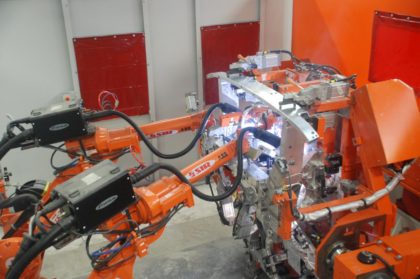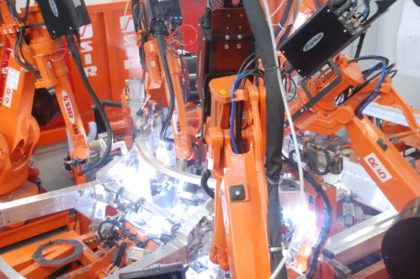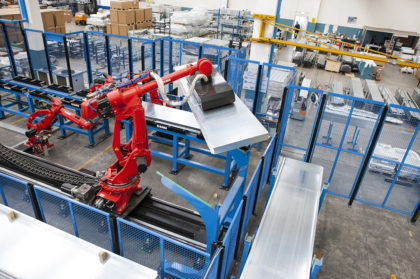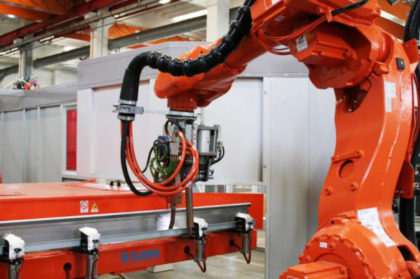Robotic welding combined with complex assembly operations is finding new applications in the manufacturing industry. The experience of SIR Soluzioni Industriali Robotizzate in a number of state-of-the-art installations, where robotics is applied vertically throughout the production cycle.
A NEW ROBOTIZATION STRATEGY
Welding was the first field in which modern robotics was applied and is still of primary importance in the automotive industry. Generally, the assembly lines on which cars are built use consolidated technologies with a high degree of maturity. Solutions become more complex if automation is used on a more global level, with the same plant incorporating applications above and beyond welding itself, ranging across a number of areas in which robotics is used, from assembly to handling, from the process to palletisation, basically creating genuine integrated welding lines. The level of complication rises even further if the production lines must be flexible enough to adapt to the continual lot changes of modern manufacturing, where the aim is to constantly reduce inventories on the one hand and customise products on the other, often with dozens of families and models. The development of robotic solutions that combine welding and assembly is technically very demanding, due to the complexity of the operations to be performed in very short cycle times. Their development must consider company strategies, production flow organisation and industrial logistics factors, to ensure cost cutting and the delivery of products with high, constant, reproducible quality. SIR spa (of Modena, Italy), one of the top system integrators on the international scene, has installed several automated lines for welding with high value-added, where the degree of integration between manipulators, end effectors and accessory devices becomes extremely high.
ROBOTIC LIFTS
Amongst the many applications, the automated production and assembly of lift doors, a solution implemented for one of the industry’s top firms, is particularly significant. The plant is subdivided into two main lines, one for the production of the door leaves and the second for the jambs, both capable of managing one-piece lots. The door leaf assembly line includes welding, grinding, assembly itself and palletisation. Upstream is a panel bender, which cuts, bends and shapes the sheet steel panels for use to produce the leaves, subdivided into 3 types on the basis of the material used. The plant’s first robot is tasked with picking these panels and placing them on an empty load unit leaving an automated warehouse. The leaves are then depalletised by a second articulated robot and loaded onto the assembly line, which starts with a labelling phase to guarantee the subsequent traceability of every single component. A pair of electric spindles fitted with abrasive discs, mounted on the end effectors of a couple of robots, remove the protective film from the steel plate in the zones where the labyrinth profile assembly, the wheels and the stiffeners are to be welded in place. The line continues with a central handling robot which first tends the system which mounts the wheels, in 2 different types of material depending on the article currently being produced, supplied in a pair of bins. The assembly robot, fitted with a custom-designed gripping system, is able to install 2 or 4 wheel units depending on the incoming article, picking them from the bins mentioned above. It is now the turn of 3 more articulated robots, which weld the fixing studs onto the wheel units (operating simultaneously due to cycle time factors). After this, the central handling robot transfers the door leaf to the input unit of the second processing system, where more articulated robots apply the glue and fit the stiffener bars and the Knock & Fill soundproofing panels, which have already been picked and located. A suitably sized presser holds the stiffener bar and panels in place while another welding robot fixes them to the structure. After the leaf has been placed on the feed line, the stiffener bar is marked with identification codes, necessary because the data of every single lift must be traceable, especially in case of accident or fire. The labyrinth profile units are assembled in the next system, which has 2 articulated robots. They are able to fit 6 different types of unit, each supplied in a different bin, depending on the incoming code. This system performs complex operations including handling of the entire leaf, positioning of the units and welding of the labyrinth profiles. At this point the door leaf is finally complete and can be placed on the outgoing conveyor belt, where a pick and place system will fill the load units for storage in the centralised warehouse.
It is important to remember that every station has functional control and testing systems capable of detecting and signalling any faults in assembly and welding in any processing step. Door leaves with problems or defects still continue on their way through the various stations, but they will be marked with spots of paint for easy identification on the exit bays.
The logistical solution described above, with similar load unit depalletisation and palletisation robots upstream and downstream of the plant, is also used for the jamb assembly line, parallel to the one described. After loading into the line, the jambs, of 4 different types and sizes, are handled by yet another articulated robot which tends a cutting machine that creates various types of customisation, such as the holes to take emergency stop buttons, push-button control panels and other devices. In the next system, the stiffeners are brushed and then spot welded to the jambs. The robot installed to load/unload the devices also tends the next station, where various types of square or round push-button control panels are collected from pallets for mounting on the jamb. Another robot welds on the control panels and supporting brackets, supplied by a vibrating feeder. The completed jamb is then palletised and sent to the central warehouse.
The component feeding systems are vital for the flexibility of both lines and must be specially developed for the various types of articles, while retaining the capability to take a range of related models and subfamilies. The welding station fixing equipment, often comprising special controlled-axis rotary positioners, also has to meet the same flexibility requirements.
WELDING AND COMPLEX ASSEMBLY IN THE AUTOMATIVE INDUSTRY
But SIR has not only worked with lifts: there are many applications, especially in the automotive industry. Mention should be made in particular of its implementations for welding and assembling the aluminium chassis of high performance cars, where the skilful combination of different technologies has brought impressive results. These lines feature a large number of parallel robots for welding the chassis subassemblies, including the front and rear parts, the side components and the central tunnel. Assembling this last item requires highly complex operations, because welding is combined with the use of adhesives to secure aluminium components, and robotic screw insertion, possible thanks to Ejot screws. Once the subassemblies are complete we come to the heart of the application, comprising a central track motion system that conveys the complex equipment on which the chassis is placed and located through the various automated stations. A handling robot picks the components and places them on the central track motion system depending on the type of operation required. The first step for the tunnel is a halt in a polymerisation furnace to dry the adhesive, before transfer to the track motion system. This then conveys the chassis into a unit with 4 parallel-operating robots, which weld the side and front parts. The chassis is then collected by the handling robot, the line’s real “operative”, which places it in an automatic measuring unit where any dimensional defects caused by the previous welding operations are detected. It then moves on to another unit, also with 4 parallel robots, where the rear part and the linking cross-member are fitted and welded. The line ends with 2 manual machining stations tended by the articulated robot, where the operative can give a number of finishing touches to the completed chassis.
THE BENEFITS OF A GLOBAL SOLUTION
It is important to realise that the automation system described above delivers considerable savings in production times and costs. For example, the automation of the lift door and jamb line handling and assembly procedures has allowed the achievement of extremely impressive cycle times, of 25 and 32 seconds respectively, thanks to production efficiency of around 95%. In the case of the automotive chassis, notwithstanding the complexity of the operations involved, the SIR line is able to turn out a complete chassis every 17 minutes. These are extraordinary results, clear proof that global robotization is modern manufacturers’ answer to the demands and challenges of competition from emerging countries. It should also be remembered that flexibility must always be absolute: in the case of the lifts, the lot size is often just one, so the entire line must be able to retool itself automatically in just a few seconds when the product changes, through procedures which replace the robot grippers, the functional components of the dedicated machines, and even the handling and process programmes themselves. The integration of different technologies has allowed the realisation of plants that, unlike conventional systems, are no longer created for a single purpose, welding pure and simple. SIR lines combine the technical automation procedures for which robotics is normally used with entire processing sequences within the production cycle. So we can safely state that, through its solutions, SIR has chosen a path that will lead it to the future of automation, well beyond welding.
Davide Passoni
R&D Department
SIR spa






